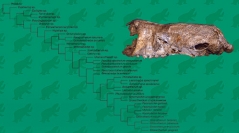

 Comptes Rendus Palevol
19 (12) - Pages 215-232
Comptes Rendus Palevol
19 (12) - Pages 215-232The late Pleistocene mylodontine sloth Glossotherium wegneri (Spillmann, 1931) (Interandean region, Ecuador) has been assigned to Glossotherium Owen, 1839 and Oreomylodon Hoffstetter, 1949 (the latter ranked as a subgenus or genus), and synonymized with G. robustum (Owen, 1842). However, the phylogenetic and comparative analyses conducted here, which include previously undescribed remains, strongly suggest specific distinction for G. wegneri and that there is little, if any, support for generic or subgeneric distinction for Oreomylodon. Among the notable features of this species are the presence of an internasal element, marked expansion of the rostrum anteriorly, and dorsoventrally and the palatal region transversely, increased separation of the caniniform tooth from the anterior edge of maxilla, increased relative braincase width, relatively enlarged hypoglossal foramen, and greatly elongated zygomatic process of the squamosal. The resulting single MPT recovered a monophyletic Glossotherium, with the following phylogenetic arrangement of the species of this genus (G. robustum + ((G. wegneri + G. tropicorum Hoffstetter, 1952) + (G. phoenesis Cartelle, De Iuliis, Boscaini & Pujos, 2019 + G. tarijense Ameghino, 1902))).
Ecuador, late Pleistocene, Mylodontidae, systematics, phylogeny, Oreomylodon, Glossotherium wegneri